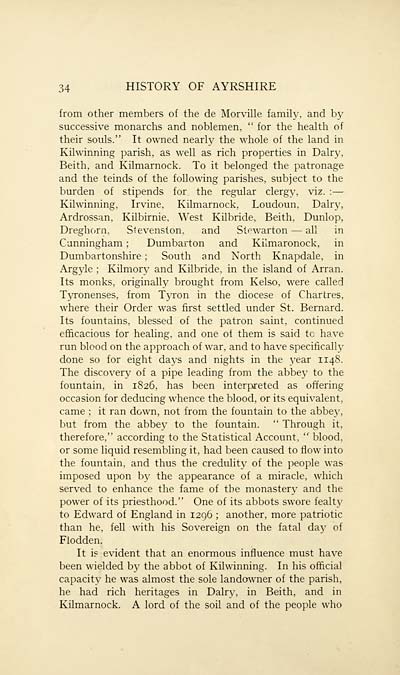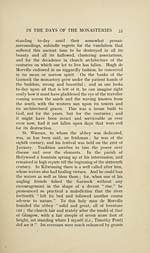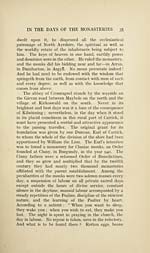Download files
Complete book:
Individual page:
Thumbnail gallery: Grid view | List view

34 HISTORY OF AYRSHIRE
from other members of the de Morville family, and by
successive monarchs and noblemen, " for the health of
their souls." It owned nearly the whole of the land in
Kilwinning parish, as well as rich properties in Dairy,
Beith, and Kilmarnock. To it belonged the patronage
and the teinds of the following parishes, subject to the
burden of stipends for the regular clergy, viz. : —
Kilwinning, Irvine, Kilmarnock, Loudoun, Dairy,
Ardrossan, Kilbirnie, West Kilbride, Beith, Dunlop,
Dreghorn, Sfevenston, and Siewarton — all in
Cunningham ; Dumbarton and Kiimaronock, in
Dumbartonshire ; South and North Knapdale, in
Argyle ; Kilmory and Kilbride, in the island of Arran.
Its monks, originally brought from Kelso, were called
Tyronenses, from Tyron in the diocese of Chartres,
where their Order was first settled under St. Bernard.
Its fountains, blessed of the patron saint, continued
efficacious for healing, and one of them is said to have
run blood on the approach of war, and to have specifically
done so for eight days and nights in the year 1148.
The discovery of a pipe leading from the abbey to the
fountain, in 1826, has been interpreted as offering
occasion for deducing whence the blood, or its equivalent,
came ; it ran down, not from the fountain to the abbey,
but from the abbey to the fountain. " Through it,
therefore," according to the Statistical Account, " blood,
or some liquid resembling it, had been caused to flow into
the fountain, and thus the credulity of the people was
imposed upon by the appearance of a miracle, which
served to enhance the fame of the monastery and the
power of its priesthood." One of its abbots swore fealty
to Edward of England in 1296 ; another, more patriotic
than he, fell with his Sovereign on the fatal day of
Flodden.
It is evident that an enormous influence must have
been wielded by the abbot of Kilwinning. In his official
capacity he was almost the sole landowner of the parish,
he had rich heritages in Dairy, in Beith, and in
Kilmarnock. A lord of the soil and of the people who
from other members of the de Morville family, and by
successive monarchs and noblemen, " for the health of
their souls." It owned nearly the whole of the land in
Kilwinning parish, as well as rich properties in Dairy,
Beith, and Kilmarnock. To it belonged the patronage
and the teinds of the following parishes, subject to the
burden of stipends for the regular clergy, viz. : —
Kilwinning, Irvine, Kilmarnock, Loudoun, Dairy,
Ardrossan, Kilbirnie, West Kilbride, Beith, Dunlop,
Dreghorn, Sfevenston, and Siewarton — all in
Cunningham ; Dumbarton and Kiimaronock, in
Dumbartonshire ; South and North Knapdale, in
Argyle ; Kilmory and Kilbride, in the island of Arran.
Its monks, originally brought from Kelso, were called
Tyronenses, from Tyron in the diocese of Chartres,
where their Order was first settled under St. Bernard.
Its fountains, blessed of the patron saint, continued
efficacious for healing, and one of them is said to have
run blood on the approach of war, and to have specifically
done so for eight days and nights in the year 1148.
The discovery of a pipe leading from the abbey to the
fountain, in 1826, has been interpreted as offering
occasion for deducing whence the blood, or its equivalent,
came ; it ran down, not from the fountain to the abbey,
but from the abbey to the fountain. " Through it,
therefore," according to the Statistical Account, " blood,
or some liquid resembling it, had been caused to flow into
the fountain, and thus the credulity of the people was
imposed upon by the appearance of a miracle, which
served to enhance the fame of the monastery and the
power of its priesthood." One of its abbots swore fealty
to Edward of England in 1296 ; another, more patriotic
than he, fell with his Sovereign on the fatal day of
Flodden.
It is evident that an enormous influence must have
been wielded by the abbot of Kilwinning. In his official
capacity he was almost the sole landowner of the parish,
he had rich heritages in Dairy, in Beith, and in
Kilmarnock. A lord of the soil and of the people who
Set display mode to:
![]() Universal Viewer |
Universal Viewer | ![]() Mirador |
Large image | Transcription
Mirador |
Large image | Transcription
Images and transcriptions on this page, including medium image downloads, may be used under the Creative Commons Attribution 4.0 International Licence unless otherwise stated. ![]()
| Histories of Scottish families > Ayrshire > Volume 1 > (44) Page 34 |
|---|
| Permanent URL | https://digital.nls.uk/95194814 |
|---|
| Attribution and copyright: |
|
|---|
| Description | A selection of almost 400 printed items relating to the history of Scottish families, mostly dating from the 19th and early 20th centuries. Includes memoirs, genealogies and clan histories, with a few produced by emigrant families. The earliest family history goes back to AD 916. |
|---|

